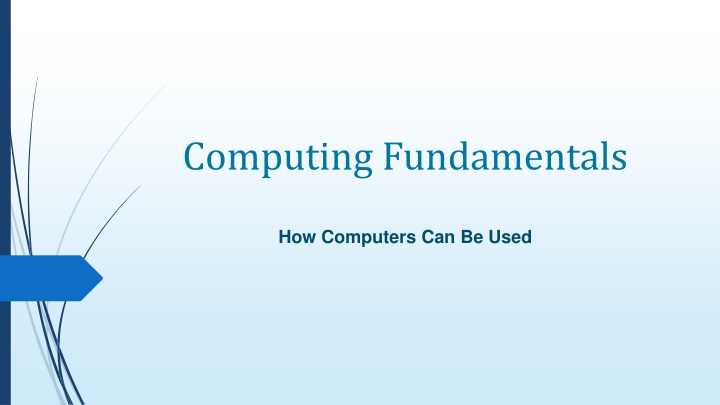
Types of Computers: Supercomputers, Mainframes, Minicomputers, Personal Computers, and More
Explore the different types of computers, including supercomputers for specialized tasks, mainframes for handling large volumes of data, minicomputers for medium-sized businesses, and personal computers for everyday use. Learn about notebook/laptop computers and their portability. Computers play a crucial role in various industries, managing information flow efficiently.
Download Presentation

Please find below an Image/Link to download the presentation.
The content on the website is provided AS IS for your information and personal use only. It may not be sold, licensed, or shared on other websites without obtaining consent from the author. If you encounter any issues during the download, it is possible that the publisher has removed the file from their server.
You are allowed to download the files provided on this website for personal or commercial use, subject to the condition that they are used lawfully. All files are the property of their respective owners.
The content on the website is provided AS IS for your information and personal use only. It may not be sold, licensed, or shared on other websites without obtaining consent from the author.
E N D
Presentation Transcript
Computing Fundamentals How Computers Can Be Used
How Computers Can Be Used Computers are used in a variety of industries to perform a multitude of tasks. Many companies have a combination of large and small systems to manage their flow of information.
Types of Computers Supercomputer Mainframe computers Minicomputers Personal computers (PC) or microcomputers Notebook/Laptop computers Tablets Personal Digital Assistants (PDA) Workstation Other Types of Computers
Supercomputer considered to be the fastest type of computer available. very expensive due to the amount of information to be processed daily. generally have specialized software programs installed such as weather forecasting, resource exploration, or animation .
Mainframe computers can simultaneously handle hundreds of different programs and users without sacrificing performance. process large volumes of data at an incredible speed. commonly found in government agencies or large organizations such as an automated teller machine (ATM). sometimes called centralized systems as they control the flow of data to and from computers or terminals.
Minicomputers typically process data at a slower rate and in smaller volumes than mainframes . as the number of users increase, there is a reduction in speed. commonly found in medium-sized manufacturing companies and legal or accounting firms. point-of-sale terminals, cash registers or retail scanners all link to minicomputers.
Personal computers (PC) or microcomputers sit on, beside, or under a desk. process data quickly. used extensively in small businesses, schools and homes. two general types of microcomputers: the PC (based on the original IBM machine), and the Macintosh designed by Apple.
Notebook/Laptop computers portable microcomputers . similar to desktop models in speed, performance and usage. can purchase accessories such as expandable keyboards . cost is the same or slightly more than a desktop computer . can purchase a notebook created for the PC or Apple environment.
Tablets appear similar to a notebook but usually the screen can be swivelled or folded over to allow the user to write or select items using a special pen designed for the tablet. have the touch screen capability where you touch the pen or stylo device to the item on screen. can also type information using the built-in keyboard.
Personal Digital Assistants (PDA) small palm-sized computers or cellular telephones used as personal organizers. have specific software to make appointments, contact lists and write notes. popular for their portability with software installed to create documents, take pictures, or connect to the Internet.
Workstation any computer that requires a lot of power for processing files, such as drafting, graphics design, video editing or programming may not have a disk drive and could be connected to a centralized system to handle the software and storage requirements operating system will be Unix or Windows . can connect to a network for multiple users to share the same software or data files.
Other Types of Computers diagnose problems with a car engine manufacturing firms using robotics automated teller machines (ATMs) heart monitoring equipment global positioning satellite (GPS) navigation tools microwaves and other home appliances calculators that use the same type of chips found in computers to perform calculations, and based on the binary/hexadecimal computations of 1 or 0 (zero)
